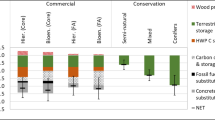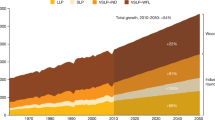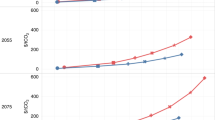Abstract
Land-use change, primarily from conventional agricultural expansion and deforestation, contributes to approximately 17% of global greenhouse-gas emissions1. The fate of cleared wood and subsequent carbon storage as wood products, however, has not been consistently estimated, and is largely ignored or oversimplified by most models estimating greenhouse-gas emissions from global land-use conversion2,3. Here, we estimate the fate of cleared wood and timing of atmospheric carbon emissions for 169 countries. We show that 30 years after forest clearance the percentage of carbon stored in wood products and landfills ranges from about 0% to 62% globally. For 90 countries, less than 5% of carbon remains after 30 years, whereas 34 countries have more than 25% in storage. Higher storage rates result primarily from a greater percentage of long-lived products such as wood panels and lumber, and tend to occur in countries with predominantly temperate forests. Alternatively, lower storage rates are associated with a greater fraction of non-merchantable wood and more wood used for energy and paper production, which tend to occur in countries with predominantly tropical forests. Hence, the country and fate of cleared wood can considerably affect the timing of greenhouse-gas emissions from forest clearance.
This is a preview of subscription content, access via your institution
Access options
Subscribe to this journal
Receive 12 print issues and online access
$209.00 per year
only $17.42 per issue
Buy this article
- Purchase on Springer Link
- Instant access to full article PDF
Prices may be subject to local taxes which are calculated during checkout




Similar content being viewed by others
References
Barker, T., Bashmakov, L., Bernstein, J. E. & Bogner, J. E. in IPCC Climate Change 2007: Mitigation (eds Metz, B., Davidson, O. R., Bosch, P. R., Dave, R. & Meyer, L. A.) (Cambridge Univ. Press, 2007).
US Environmental Protection Agency Renewable Fuel Standard Program (RFS2) Regulatory Impact Analysis Report No. EPA-420-R-10-006 (US EPA, 2010).
EU Joint Research Centre Indirect Land use Change from Increased Biofuels Demand Report No. EUR 24485 EN (EU Joint Research Centre, 2010).
Lambin, E. F. & Meyfroidt, P. Global land use change, economic globalization, and the looming land scarcity. Proc. Natl Acad. Sci. USA 108, 3465–3472 (2011).
Gibbs, H. K. et al. Tropical forests were the primary sources of new agricultural land in the 1980s and 1990s. Proc. Natl Acad. Sci. USA 107, 16732–16737 (2010).
Searchinger, T. et al. Use of US croplands for biofuels increases greenhouse gases through emissions from land use change. Science 319, 1238–1240 (2008).
Fargione, J., Hill, J., Tilman, D., Polasky, S. & Hawthorne, P. Land clearing and the biofuel carbon debt. Science 319, 1235–1238 (2008).
Melillo, J. M. et al. Indirect emissions from biofuels: How important? Science 326, 1397–1399 (2009).
Plevin, R. J., O’Hare, M., Jones, A. D., Torn, M. S. & Gibbs, H. K. Greenhouse gas emissions from biofuels’ indirect land use change are uncertain but may be much greater than previously estimated. Environ. Sci. Technol. 44, 8015–8021 (2010).
Hertel, T. W. et al. Effects of US maize ethanol on global land use and greenhouse gas emissions: Estimating market-mediated responses. Bioscience 60, 223–231 (2010).
Lapola, D. M. et al. Indirect land-use changes can overcome carbon savings from biofuels in Brazil. Proc. Natl Acad. Sci. USA 107, 3388–3393 (2010).
Arima, E. Y., Richards, P., Walker, R. & Caldas, M. M. Satistical confirmation of indirect land use change in the Brazilian Amazon. Environ. Res. Lett. 6, 024010 (2011).
Marland, G. & Schlamadinger, B. Biomass fuels and forest-management strategies: How do we calculate the greenhouse-gas emissions benefits? Energy 20, 1131–1140 (1995).
Schlamadinger, B. & Marland, G. The role of forest and bioenergy strategies in the global carbon cycle. Biom. Bioener. 10, 275–300 (1996).
Marland, G. & Schlamadinger, B. Forests for carbon sequestration or fossil fuel substitution? A sensitivity analysis. Biom. Bioener. 13, 389–397 (1997).
Pingoud, K., Perala, A-L. & Pussinen, A. Carbon dynamics in wood products. Mitigat. Adapt. Strateg. Glob. Change 6, 91–111 (2001).
Miner, R. & Perez-Garcia, J. The greenhouse gas and carbon profile of the global forest products industry. For. Product. J. 57, 80–90 (2007).
Skog, K. E. Sequestration of carbon in harvested wood products for the United States. For. Produc. J. 58, 56–72 (2008).
Pingoud, K., Pohjola, J. & Valsta, L. Assessing the integrated climatic impacts of forestry and wood products. Silva Fenn. 44, 155–175 (2010).
Heath, L. S. et al. Greenhouse gas and carbon profile of the US forest products industry. Environ. Sci. Technol. 44, 3999–4005 (2010).
Baccini, A. et al. Estimated carbon dioxide emissions from tropical deforestation improved by carbon-density maps. Nature Clim. Change 2, 182–185 (2012).
IPCC IPCC Guidelines for National Greenhouse Gas Inventories Vol. 4 (IGES Japan, 2006).
Food and Agricultural Organization Forest Resources Assessment (FAO, 2010).
Ince, P. J., Kramp, A. D., Skog, K. E., Spelter, H. N. & Wear, D. N. US Forest Products Module: A Technical Document Supporting the Forest Service 2010 RPA Assessment Research paper FPL-RP-662 Report No. USDA Forest Service (Forest Products Laboratory, 2011).
Marland, E. S., Stellar, K. & Marland, G. H. A distributed approach to accounting for carbon in wood products. Mitigation Adapt. Strat. Glob. Change 15, 71–91 (2010).
Acknowledgements
J.M.E. and S.Y. acknowledge the financial support from the David and Lucile Packard Foundation and the California Air Resources Board. J.M.E. acknowledges Sustainable Transportation Center fellowship support. Any mistakes or errors are the responsibility of the authors alone.
Author information
Authors and Affiliations
Contributions
J.M.E. and S.Y. identified research questions and conceptualized the study. J.M.E. constructed the model and carried out the analysis. J.M.E, S.Y. and K.E.S. analysed the results and revised/improved the study approach.
Corresponding author
Ethics declarations
Competing interests
The authors declare no competing financial interests.
Supplementary information
Rights and permissions
About this article
Cite this article
Mason Earles, J., Yeh, S. & Skog, K. Timing of carbon emissions from global forest clearance. Nature Clim Change 2, 682–685 (2012). https://doi.org/10.1038/nclimate1535
Received:
Accepted:
Published:
Issue Date:
DOI: https://doi.org/10.1038/nclimate1535
This article is cited by
-
Extreme Level of CO2 Accumulation into the Atmosphere Due to the Unequal Global Carbon Emission and Sequestration
Water, Air, & Soil Pollution (2022)
-
Forest management in southern China generates short term extensive carbon sequestration
Nature Communications (2020)



